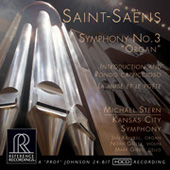
DEFINITIVE RECORDINGS

With all of the incredibly good extant recordings already available of the wonderful Symphony No. 3 "Organ" by Camille Saint-Saëns (1835-1921),
any performers releasing a new recording of it should be ready and able to challenge the top contenders or otherwise stay home. Here are, in my opinion, a few pointers as to how it should be done.
1- Open the first movement with a broad tempo and a richness of tone foreshadowing the events to come.
2- When the slow movement begins, allow the sound of the organ and strings to slide into its deep harmonic waters and dissolve together to become one entity.
3- Bring out that movement's beautiful melody by means of expressive phrasing, balanced nuances and well controlled rubato.
4- And don't be shy or afraid to offend. Before the final movement begins, activate the pipe organ's plein-jeux so that the massive opening chord is not only heard, but also felt.
5- Give this movement all the pomp and majesty it begs for. It certainly rivals any of the best British regal marches.
6- Make sure the final chord is so powerful as to make anyone who hears it glad to be alive.
7- Never record the orchestra and organ in two different locations and then mix the two together at a later date. Dynamic balance compromises will have to be made and ruin the sense of occasion.
8- Last but not least, capture all this with a superbly engineered recording.
As for organist Jan Kraybill, conductor Michael Stern, the members of the Kansas City Symphony Orchestra and the recording engineers
at Reference Recordings, they don't need to follow these tips. They already have all of this down and then some. Some have come very close, but I've never heard such a well-rounded
account of this impressive symphonic work. Under Michael Stern's direction, the slow movement glows with expressive touches and the final movement blows everyone else out of the water. The
impressive Casavant pipe organ which has 4 keyboards, 79 stops, 102 ranks, tracker action, and 5,548 pipes, the biggest of which weighs 960 pounds, certainly produces a hair-raising sound when
it opens the final movement. Unsuspecting listeners beware: crank up the volume but brace yourself for a jolt. The only way to truly enjoy recordings like this one is to play them loud - the way
a full orchestra and hefty pipe organ are meant to sound.
Included on this recording are Introduction and Rondo capriccioso for Violin and Orchestra and La muse et le počte for Violin,
Cello and Orchestra, both receiving the same level of musicianship and attention to detail given the main attraction. As if the symphony wasn't enough. They are the icing on the cake.
Violinist Noah Geller and cellist Mark Gibbs are both members of the Kansas City Symphony Orchestra. They play these pieces so well
and with so much expressive conviction, that until I read the booklet notes I assumed they were veterans of the stage and/or seasoned soloist performers.
Glorious music making reproduced with stupendous fidelity!
Jean-Yves Duperron - June 2015